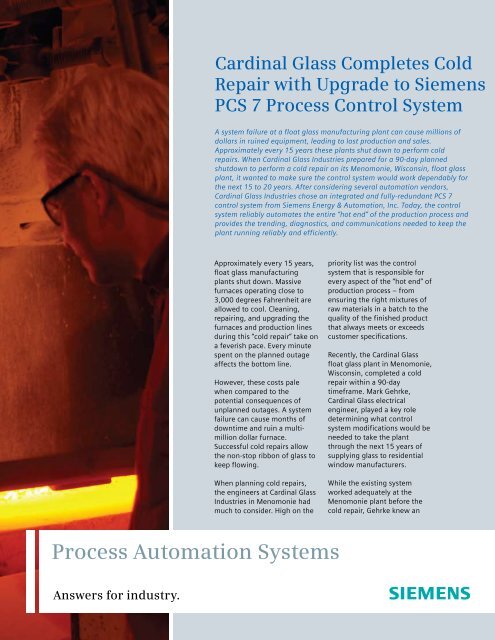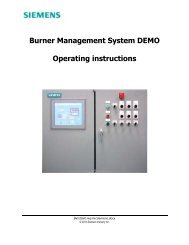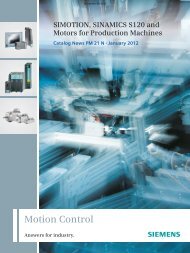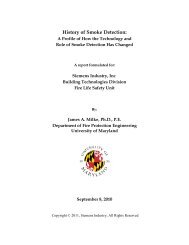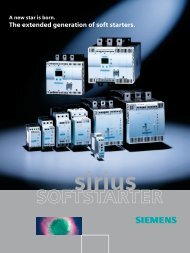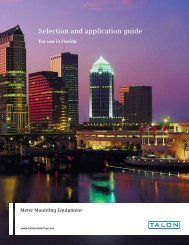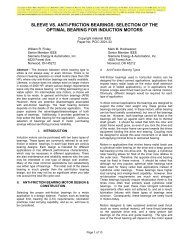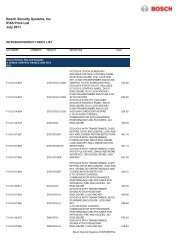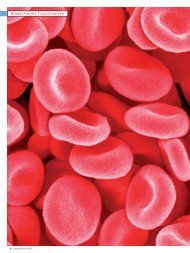Process Automation Systems - Siemens Industry, Inc.
Process Automation Systems - Siemens Industry, Inc.
Process Automation Systems - Siemens Industry, Inc.
You also want an ePaper? Increase the reach of your titles
YUMPU automatically turns print PDFs into web optimized ePapers that Google loves.
Cardinal Glass Completes Cold<br />
Repair with Upgrade to <strong>Siemens</strong><br />
PCS 7 <strong>Process</strong> Control System<br />
A system failure at a float glass manufacturing plant can cause millions of<br />
dollars in ruined equipment, leading to lost production and sales.<br />
Approximately every 15 years these plants shut down to perform cold<br />
repairs. When Cardinal Glass Industries prepared for a 90-day planned<br />
shutdown to perform a cold repair on its Menomonie, Wisconsin, float glass<br />
plant, it wanted to make sure the control system would work dependably for<br />
the next 15 to 20 years. After considering several automation vendors,<br />
Cardinal Glass Industries chose an integrated and fully-redundant PCS 7<br />
control system from <strong>Siemens</strong> Energy & <strong>Automation</strong>, <strong>Inc</strong>. Today, the control<br />
system reliably automates the entire “hot end” of the production process and<br />
provides the trending, diagnostics, and communications needed to keep the<br />
plant running reliably and efficiently.<br />
Approximately every 15 years,<br />
float glass manufacturing<br />
plants shut down. Massive<br />
furnaces operating close to<br />
3,000 degrees Fahrenheit are<br />
allowed to cool. Cleaning,<br />
repairing, and upgrading the<br />
furnaces and production lines<br />
during this “cold repair” take on<br />
a feverish pace. Every minute<br />
spent on the planned outage<br />
affects the bottom line.<br />
However, these costs pale<br />
when compared to the<br />
potential consequences of<br />
unplanned outages. A system<br />
failure can cause months of<br />
downtime and ruin a multimillion<br />
dollar furnace.<br />
Successful cold repairs allow<br />
the non-stop ribbon of glass to<br />
keep flowing.<br />
When planning cold repairs,<br />
the engineers at Cardinal Glass<br />
Industries in Menomonie had<br />
much to consider. High on the<br />
priority list was the control<br />
system that is responsible for<br />
every aspect of the “hot end” of<br />
production process – from<br />
ensuring the right mixtures of<br />
raw materials in a batch to the<br />
quality of the finished product<br />
that always meets or exceeds<br />
customer specifications.<br />
Recently, the Cardinal Glass<br />
float glass plant in Menomonie,<br />
Wisconsin, completed a cold<br />
repair within a 90-day<br />
timeframe. Mark Gehrke,<br />
Cardinal Glass electrical<br />
engineer, played a key role<br />
determining what control<br />
system modifications would be<br />
needed to take the plant<br />
through the next 15 years of<br />
supplying glass to residential<br />
window manufacturers.<br />
While the existing system<br />
worked adequately at the<br />
Menomonie plant before the<br />
cold repair, Gehrke knew an<br />
<strong>Process</strong> <strong>Automation</strong> <strong>Systems</strong><br />
Answers for industry.
Glass is tested for proper thickness across its entire width. Any defects are discarded and recycled.<br />
upgrade was in order. He needed a fully<br />
redundant control system with open<br />
communication interfaces and flexibility.<br />
He also wanted a system that would<br />
provide comprehensive and easy-to-use<br />
trending of process data for analysis. But,<br />
above all, reliability topped his selection<br />
criteria.<br />
After evaluating options from a number of<br />
vendors, he chose an integrated<br />
automation and control system from<br />
<strong>Siemens</strong> Energy & <strong>Automation</strong>.<br />
“The redundancy of the <strong>Siemens</strong> PCS 7<br />
system was much better than the other<br />
systems we looked at,” Gehrke says. “That<br />
was one of the main driving forces. We<br />
tested a rack of controllers from <strong>Siemens</strong><br />
as well as the other vendors. There were<br />
fewer steps involved in implementing a<br />
<strong>Siemens</strong> redundant system. If we wanted<br />
to add I/O on the other systems we would<br />
have had to flip ones and zeros. The<br />
<strong>Siemens</strong> system was also very easy to<br />
implement.”<br />
The upgrade solution chosen for the<br />
Menomonie plant was a fully redundant<br />
<strong>Siemens</strong> SIMATIC® PCS 7 control system,<br />
operator station, engineering station,<br />
Masterdrive variable frequency drives,<br />
PROFIBUS I/O, and more than 30 SITRANS<br />
pressure and temperature transmitters. To<br />
take advantage of a digital fieldbus and to<br />
bring it all seamlessly together, Cardinal<br />
Glass replaced the electronics in its<br />
existing analog 4-20 type instruments with<br />
PROFIBUS PA communications capable<br />
modules.<br />
“PROFIBUS helped us eliminate a lot of<br />
manual tweaking at the engineering<br />
station,” Gehrke says. “Also, we chose to<br />
place a controller in each of our production<br />
areas even though we could have used just<br />
one controller for the entire operation. We<br />
chose to keep it broken up because of<br />
redundancy and the ability to isolate<br />
problems.”<br />
Gerhke says a big reason why the<br />
Menomonie plant met its 90-day schedule<br />
for the cold repair was he was able to<br />
retrofit the existing control cabinets with<br />
the new PCS 7 hardware.<br />
“We basically gutted the cabinets and<br />
started over,” Gehrke says “We saved the<br />
wire connections and put terminal blocks<br />
in the bottom. It was the only way we<br />
could have done it on time and on<br />
budget.”<br />
From Batch House to Cutting<br />
The float glass manufacturing process<br />
begins when a precise formulation of eight<br />
raw materials are mixed in the plant’s<br />
batch house. The PCS 7 system<br />
communicates to two S7 417 controllers<br />
(one each for manual operations and<br />
unloading) as well as to a S7 417 H<br />
controller for batching that ensures the<br />
correct amounts of raw materials are<br />
charged into the furnace. At the same<br />
time, cullet (recycled glass) is mixed with<br />
the other raw materials.
This batch is conveyed into the furnace by<br />
means of a batch charger. Here natural gas<br />
and air are combined in a stoichiometric<br />
mixture to create the temperatures<br />
necessary to reduce the raw materials to a<br />
liquid state. The PCS 7 system monitors<br />
and controls all furnace temperatures<br />
through the controllers and makes input<br />
changes as required. The waste gases<br />
generated during the melting process are<br />
monitored by another controller that<br />
automates an electrostatic precipitator<br />
system to reduce air emissions.<br />
Gehrke says even small problems during<br />
this process can result in days of wasted<br />
product. Glass melting is a timetemperature<br />
process, so there can be up to<br />
three days worth of glass being melted<br />
and refined. If a slight error is made in<br />
batching, heating, or cooling, many tons<br />
of product are wasted.<br />
“Think of the production process as a<br />
river,” Gehrke says. “The flow has eddies<br />
that will bleed off into the ribbon for days<br />
or weeks or months. The control system<br />
minimizes the risk of these problems that<br />
can go on for days, weeks, or months.”<br />
As the glass enters the tin bath, or forming<br />
section, of the line, the glass temperature<br />
is approximately 2,200 degrees<br />
Fahrenheit. Once inside the tin bath, the<br />
glass floats atop molten tin where the top<br />
roll machines precisely adjust the width<br />
and thickness of the molten glass. The<br />
tweel, or refractory gate, controls the flow<br />
of the molten glass into the tin bath.<br />
Operators in the plant’s control room can<br />
instantaneously adjust the flow of the<br />
glass through the tweel as needed.<br />
Resistive heating elements, hanging above<br />
the glass flowing on molten tin, heat<br />
different areas of the ribbon to ensure<br />
correct thickness and width.<br />
The heat of the tin bath is maintained by a<br />
Thyro-P power controller that is integrated<br />
into the PCS 7 control system. Each top roll<br />
machine is controlled by a <strong>Siemens</strong><br />
Masterdrive variable frequency drive and<br />
synchronous motors connected to the<br />
control system via PROFIBUS. The<br />
coordination between the drives, motors<br />
and control system delivers the precise<br />
adjustments to form the glass to within a<br />
1,000th of an inch as well as maintains an<br />
internal atmosphere of nitrogen and<br />
hydrogen to prevent oxidation of the<br />
molten tin.<br />
“We maintain the atmosphere in the tin<br />
bath with actuators and SITRANS pressure<br />
transmitters that are connected by<br />
PROFIBUS PA to the hazardous area<br />
controller,” Gehrke says. “This patented<br />
process keeps defects out and provides a<br />
clear surface on top of the glass.“<br />
Now exiting the tin bath, lift-out rolls pull the<br />
ribbon of glass into the lehr where the glass is<br />
annealed. The lehr gradually cools the glass<br />
and is controlled by <strong>Siemens</strong> Masterdrive<br />
drives. This carefully controlled cooling<br />
process, also automated by the PCS 7 system<br />
and hazardous area controller, ensures the<br />
proper strength of the glass and the ability to<br />
cut the finished products, ranging from 1.6 to<br />
7.0 mm thick residential windows.<br />
Because the variable frequency drives are<br />
programmed using PROFIBUS and also<br />
communicate via PROFIBUS to the PCS 7<br />
system, engineers can quickly replace<br />
drives and configurations as needed.<br />
Gerhke says this ability to quickly<br />
download the configuration parameters<br />
online changes reduces downtime at the<br />
plant and does not effect operation.<br />
Additionally, because Cardinal Glass can<br />
now monitor the temperature and health<br />
of all its PROFIBUS PA instrumentation,<br />
downtime is further reduced.<br />
“We get much better feedback over<br />
PROFIBUS,” Gehrke says. “Operators know<br />
right away when a device is about to go<br />
bad or is overheating. Those diagnostics<br />
allows us to make adjustments before an<br />
instrument goes down.”<br />
As the glass exits the lehr it is tested for<br />
proper thickness across the entire width of<br />
glass. If any portion of the glass falls outside<br />
of specifications that portion is automatically<br />
marked and discarded to be recycled in the<br />
batch house. Additionally, a laser inspection<br />
booth positioned over the line permits an<br />
even closer analysis of 100 percent of the<br />
glass to detect defects and distortion.<br />
Cardinal Glass engineers say a big reason the Menomonie plant met its cold<br />
repair schedule was because they saved time by retrofitting the existing<br />
Bailey control cabinets with new PCS 7 hardware.<br />
Computer controlled cross cutters score<br />
the glass according to particular customer<br />
orders. The main line then snaps the glass<br />
at the scores and edges are trimmed to<br />
specifications. Trimmed glass and waste<br />
are fed back into the batch house to be<br />
used as cullet. The finished products are<br />
finally steered down individual lines where<br />
they are packed and shipped to residential<br />
window and door manufacturers.
Operators in the central control room use video to monitor a furnace<br />
that is maintained at target temperature by the PCS 7 system.<br />
More than 30 SITRANS pressure and temperature transmitters are<br />
connected by PROFIBUS PA to the PCS 7 system.<br />
“Throughout the entire process, operators<br />
can look at parameters that we never had<br />
access to before,” Gehrke says. “Now they<br />
can reset faults themselves and analyze<br />
process data fast trends. Before, they had<br />
to call me to handle the problem.”<br />
Non-Stop Reliability<br />
Chris Granley is engineering manager at<br />
the Menomonie plant whose primary job is<br />
to ensure everything in the plant runs nonstop<br />
until the next cold repair in 15 years.<br />
“I have been very impressed with the<br />
reliability of the <strong>Siemens</strong> PCS 7 control<br />
system. We have had no issues with the<br />
hot end control system since the<br />
switchover to the <strong>Siemens</strong> PCS 7”.<br />
The switchover over to the PCS 7 has<br />
provided him several useful tools.<br />
He likes to use the trending, diagnostic,<br />
and alarm features of the PCS 7 to monitor<br />
system performance and diagnose any<br />
problems with the process equipment.<br />
Conclusion<br />
Mark Kehne, production manager at the<br />
plant, has also learned to rely on the PCS 7<br />
system to help meet his production<br />
objectives. Referring to himself as an end<br />
user, Kehne works closely with Gehrke to<br />
improve quality and output.<br />
“Our new process is much more<br />
streamlined than before the cold repair,”<br />
Kehne says. “I use the system as a tool to<br />
help me problem solve and do root cause<br />
analyses. The PCS 7 system has removed<br />
much of the potential for error. If it sees<br />
something moving this way when it should<br />
be moving another way, it either<br />
automatically compensates for the<br />
problem or alerts the operator to the<br />
situation.”<br />
Kehne says he now achieves results faster<br />
and can fine tune the closed loops more<br />
easily. In the past, he says production<br />
adjustments were often too fast or too<br />
slow. Operators would also sometimes<br />
over compensate or under compensate<br />
parameter changes.<br />
“Now I can give Mark Gehrke the feedback,<br />
and together we accomplish our goals with<br />
fewer iterations of revisiting the same<br />
thing as we typically experienced prior to<br />
cold repair,” Kehne says. “The new control<br />
system is far superior to what we had<br />
before the cold repair.”<br />
“Reliability is the most important part of<br />
the control system,” Gehrke says. “The<br />
PCS 7 system has met all of our<br />
expectations for reliability – not only by<br />
performing flawlessly, but helping the<br />
plant to quickly resolve operation<br />
problems. It is nice not getting the 1 a.m.<br />
wakeup calls about production events that<br />
our operators can now correct on their<br />
own.”<br />
Today, Gehrke says PCS 7 control system<br />
continues to reliably automate the entire<br />
hot end of the production process and<br />
provides the trending, diagnostics and<br />
communications needed to keep the plant<br />
running for the next 15 years.<br />
<strong>Siemens</strong> Energy & <strong>Automation</strong>, <strong>Inc</strong>.<br />
3333 Old Milton Parkway<br />
Alpharetta, GA 30005<br />
1-800-964-4114<br />
info.sea@siemens.com<br />
www.sea.siemens.com/process<br />
Order No.: PAFL-00102-0808<br />
All rights reserved<br />
Printed in USA<br />
© 2008 <strong>Siemens</strong> Energy & <strong>Automation</strong>, <strong>Inc</strong>.<br />
The information provided in this brochure contains merely<br />
general descriptions or characteristics of performance<br />
which in case of actual use do not always apply as described<br />
or which may change as a result of further development<br />
of the products. An obligation to provide the respective<br />
characteristics shall only exist if expressly agreed in the<br />
terms of contract.<br />
All product designations may be trademarks or product<br />
names of <strong>Siemens</strong> AG or supplier companies whose use by<br />
third parties for their own purposes could violate the rights<br />
of the owners.


